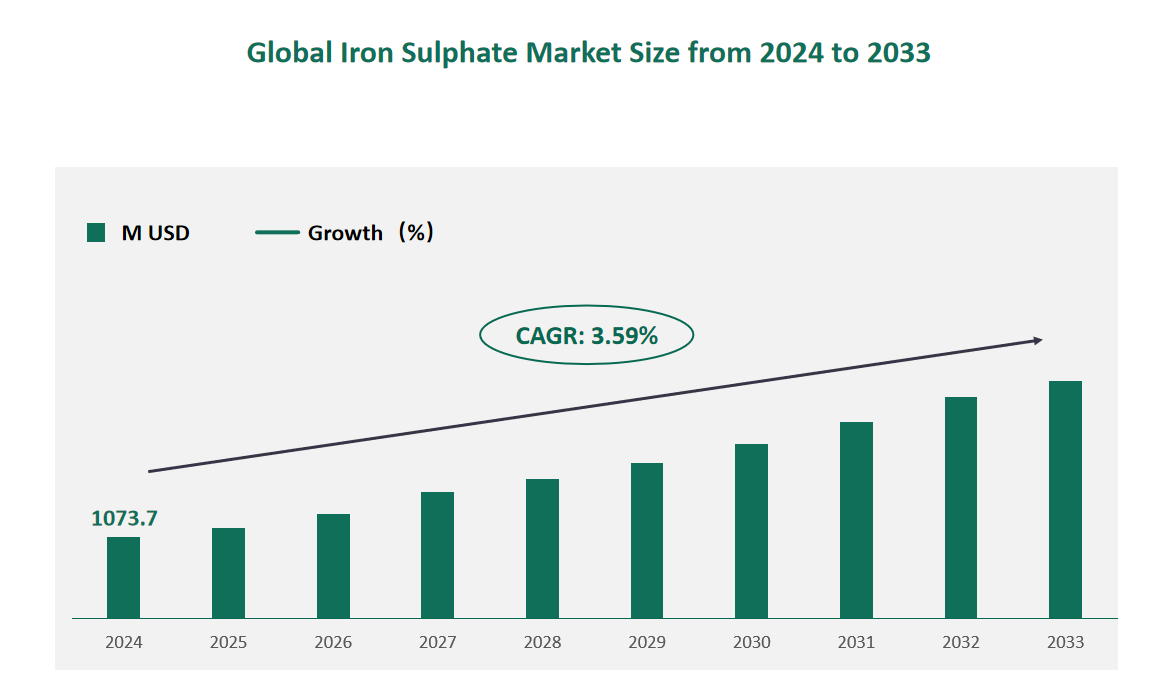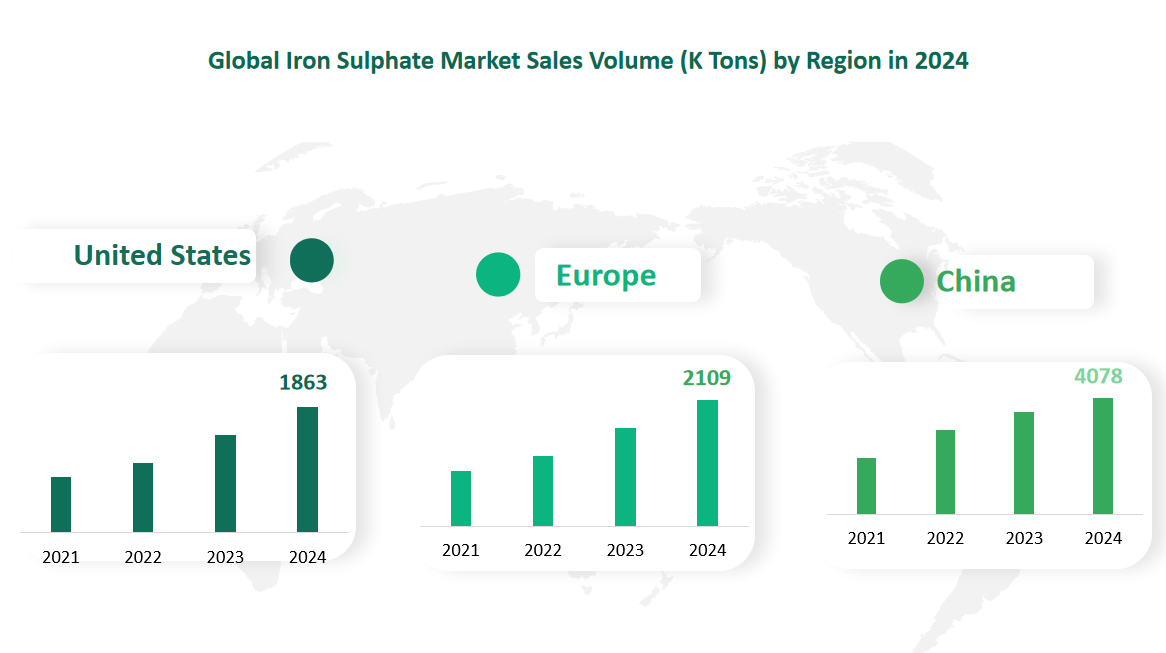1 Global Iron Sulphate Market Size (Value) and CAGR (2024-2033)
Iron Sulphate, also known as ferrous sulfate, is a chemical compound with the formula FeSO4·xH2O, where x indicates the number of water molecules of hydration. It exists in various forms, including heptahydrate, which is commonly produced during the manufacture of titanium dioxide and is used in a range of applications from water treatment to pigment production.
The Iron Sulphate market is projected to experience significant growth in the coming years, with the total global Iron Sulphate value reaching $1,073.7 million in 2024, as forecasted, with a Compound Annual Growth Rate (CAGR) of 3.59% from 2024 to 2033.
Figure Global Iron Sulphate Market Size (M USD) and CAGR 2024-2033

2 Iron Sulphate Market Growth Drivers and Challenges
The growth of the Iron Sulphate market is propelled by several key drivers. Primarily, the market is driven by the downstream demand from industries such as titanium products, pigments, feed, and water treatment. The development of these sectors increases the market demand for Iron Sulphate, indicating a direct correlation between industrial growth and the consumption of Iron Sulphate.
Additionally, the market is influenced by technological advancements that enable the production of higher quality and more affordable Iron Sulphate products. These innovations not only meet the growing market demand but also create new opportunities for expansion. Environmental regulations that promote the use of Iron Sulphate in water treatment and waste management also contribute to market growth, as they create a need for effective and compliant solutions.
Despite the growth drivers, the Iron Sulphate market also faces significant challenges. One of the primary challenges is the fluctuation in raw material prices, particularly sulfuric acid, which is a key input in the production of Iron Sulphate. These price fluctuations can impact the cost of production and, consequently, the market price of Iron Sulphate.
Rising labor costs present another challenge, as they increase the overall production costs and may affect the industry’s competitiveness.
3 Industry Entry Barriers in the Iron Sulphate Market
The Iron Sulphate market presents several barriers to new entrants. Financial barriers are significant, as the industry requires substantial initial investment in factories and equipment. The need for economies of scale to reduce production costs acts as a deterrent for small-scale players.
Technical barriers are also high, with the market demanding high-quality products that meet strict specifications for various applications, such as feed grade and food grade Iron Sulphate. This requires advanced production technology and rigorous quality control measures.
Talent barriers are another challenge, as the industry requires a skilled workforce and expertise in chemical engineering and environmental management. Additionally, established brands have a loyal customer base, making it difficult for new players to gain market share.
The need for compliance with environmental regulations and the associated costs further increase the barrier to entry, as new entrants must invest in compliant production processes and waste management systems.
4 Global Iron Sulphate Market Size and Share by Type in 2024
The global Iron Sulphate market is characterized by a diverse range of product types, each serving distinct applications and market demands.
Technical Grade Iron Sulphate, projected to generate the highest revenue in 2024, is primarily used in industrial applications. This grade is employed in the manufacturing of iron salts, inks, mordants, bleaching agents, dyes, wood preservatives, and disinfectants. With an expected revenue of $499.7 million USD in 2024, technical grade accounts for the largest share of the market due to its widespread use in various chemical and industrial processes. The versatility of technical grade Iron Sulphate in different sectors drives its market demand, making it a key player in the Iron Sulphate market.
Food Grade Iron Sulphate is used as a nutritional supplement (iron fortifier) and fruit and vegetable color development agent in the food industry. Projected to have a revenue of $191.6 million USD in 2024, this type of Iron Sulphate is crucial for enhancing the nutritional value of food products and maintaining color quality. The stringent quality requirements for food grade products make it a specialized segment within the Iron Sulphate market, with a significant focus on safety and health standards.
Feed Grade Iron Sulphate is often used as an iron supplement in animal feed, contributing to the prevention of anemia in livestock and enhancing their disease resistance during growth. With an expected revenue of $228.7 million USD in 2024, feed grade Iron Sulphate plays a vital role in the animal feed industry. Its high iron content, solubility, and purity make it an ideal ingredient for feed processing production.
Table Global Iron Sulphate Market Size and Share by Type in 2024
Type | Market Size (M USD) 2024 | Market Share 2024 |
Technical Grade | 499.7 | 46.54% |
Food Grade | 191.6 | 17.85% |
Feed Grade | 228.7 | 21.30% |
Other | 153.6 | 14.31% |
5 Global Iron Sulphate Market Size and Share by Application in 2024
The global Iron Sulphate market is segmented into various applications, each with its own market scale and growth trajectory.
The Iron Oxide Pigment application is expected to generate a revenue of $108.7 million USD in 2024. Iron Sulphate is used as a raw material for the manufacture of magnetic iron oxide, iron oxide red, and iron blue inorganic pigments. These pigments are reliable tinters suitable for various mediums, including arts and crafts, plasters, and cements. The demand for high-quality pigments in the construction, automotive, and paint industries drives the market for Iron Sulphate in this application.
Projected to have a revenue of $265.7 million USD in 2024, the Water Treatment application utilizes Iron Sulphate as a flocculant. It is highly effective in treating alkalinity in sewage and removing phosphates from urban and industrial wastewater, thus preventing eutrophication of water bodies. The growing emphasis on water purification and pollution control is a key factor contributing to the growth of this segment.
The Feed application is anticipated to have a revenue of $276.6 million USD in 2024. Iron Sulphate, in this case, serves as a feed additive, particularly as an iron supplement for livestock. It plays a crucial role in preventing anemia in animals and enhancing their disease resistance during growth. The increasing demand for fortified animal feed to improve livestock health and productivity is a significant driver for this application.
Table Global Iron Sulphate Market Size and Share by Application in 2024
Application | Market Size (M USD)2024 | Market Share 2024 |
Iron Oxide Pigment | 108.7 | 10.12% |
Water Treatment | 265.7 | 24.74% |
Feed | 276.6 | 25.76% |
Others | 422.8 | 39.37% |
6 Global Iron Sulphate Market Sales Volume (K Tons) by Region in 2024
The global Iron Sulphate market is also characterized by regional variations in sales volume.
United States is expected to have a sales volume of 1,863 K Tons in 2024. The region’s mature industrial base and strict environmental regulations contribute to a stable demand for Iron Sulphate, particularly in water treatment and pigment production.
Europe is projected to have a sales volume of 2,109 K Tons in 2024. The region’s strong chemical industry and investments in environmental protection technologies drive the market for Iron Sulphate. Additionally, Europe’s regulatory landscape supports the use of Iron Sulphate in pollution control and waste management.
China is anticipated to have a sales volume of 4,078 K Tons in 2024. The rapid industrialization and urbanization in countries like China and India have led to an increased demand for Iron Sulphate in water treatment and construction industries.
Japan and India are expected to have sales volumes of 703 K Tons and 1197 K Tons, respectively, in 2024. These regions are experiencing growth in their industrial sectors, with an increasing focus on sustainable practices and environmental protection, which is driving the demand for Iron Sulphate.
Figure Global Iron Sulphate Market Sales Volume (K Tons) by Region in 2024

7 Major Players in Global Iron Sulphate Market
7.1 Lomon Billions Group
Lomon Billions Group, established in 2011 and headquartered in China, operates on a global scale. The company has a comprehensive global chemical industry chain and its total output exceeds 40 billion RMB, with seven production bases and strong financial support.
Lomon Billions Group’s product offerings include a range of Iron Sulphate products such as iron concentrate, feed additive ferrous sulfate, and various industrial grades of ferrous sulfate monohydrate, tetrahydrate, and heptahydrate.
In 2022, the company achieved a revenue of $191.2 million USD with a gross margin of 45.10%.
7.2 Venator Materials
Venator Materials, founded in 2017 and based in the UK, has a significant presence in North America, Europe, and the Asia Pacific.
The company is known for its extensive sales channels and strong innovative thinking. Venator Materials offers ferrous sulfate heptahydrate, a cost-efficient source of iron used in water treatment, pigment production, and cement production.
In 2022, Venator Materials recorded a revenue of $129.7 million USD, with a gross margin of 54.23%.
7.3 Guangxi Jinmao Titanium
Guangxi Jinmao Titanium, established in 1970 and headquartered in China, has a global sales reach. The company is recognized for its long history and industry experience, with a complete global supply chain system.
Its product offerings include ferrous sulfate heptahydrate, which is used as a water purifier, sewage treatment agent, iron fertilizer, and in the preparation of catalysts and iron oxide pigments.
In 2022, Guangxi Jinmao Titanium reported a revenue of $23.6 million USD, with a gross margin of 49.77%.

